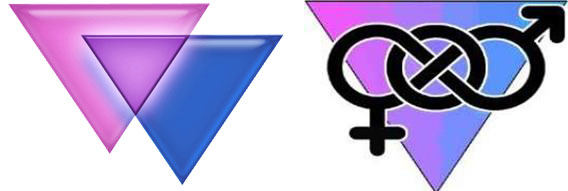LGBT Symbols

Lesbian, Gay, Bisexual, Transgender, Queer/Questioning, Intersex, and Ally (sometimes also Asexual)
Rainbow Flag

Use of the rainbow colored flag to symbolize pride goes back to 1978 at a San Francisco Gay and Lesbian Freedom Day Parade. Designed by Gilbert Baker, the colors in the flag represent the diversity of the community and have come to represent LGBTQIA pride everywhere in the world it is displayed.
Inverted Triangles

Use of inverted triangles as a symbol of gay pride began to be widespread in the early 1970s Gay Liberation Movement. It was adopted to remember that homosexuals were forced to wear a pink triangle in the Nazi Concentration Camps of World War II. Since the pink triangle has been generally a gay male symbol, a pink triangle in a black circle, or simply a black triangle, is sometimes used by lesbians.
Lambda

Lambda, the Greek letter “L”, has been used since the early 1970s to denote LGBTQ pride, possibly because “L” stand for Liberation. Some people think It may also refer to same-sex love in ancient Greek culture.
Labrys

This axe, called a labrys, was adopted from matriarchal societies to symbolize the strength and courage of lesbians or women-loving-women.
Lesbian and Gay

Various forms of the double interlocking biological symbols for female and male are used to identify lesbians and gay men. As is represented in this symbol, pink and lavender are colors that commonly represent same-sex relationships.
Bisexual

These pink, blue, and lavender triangles and interlocking biological symbols represent bisexuality, people whose attraction is to both men and women. Bisexual pride means that no matter what the sex of your partner is, you prefer to be identified as bisexual rather than heterosexual or homosexual.
Transgender

The image on the left, which combines and alters the biological sex symbols, represents people whose gender identities do not match their biological sex identities and who therefore see themselves as transgendered. Like bisexuals, transgendered people do not see themselves as heterosexual or homosexual depending on the gender identity of their partners. Transgendered persons may also be attracted to other transgendered persons.
On the right is the transgender flag which represents the gendered colors of pink and blue but which are joined in the center by a third alternative.
LGBTQ Equality Symbols

The blue symbol is the logo of the HRC (Human Rights Campaign), which has come to represent equality for all persons regardless of their sexuality and gender identities. The red symbol on the right has been more recently adopted to represent the marriage equality movement.
